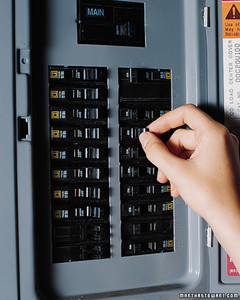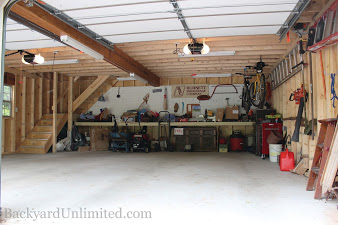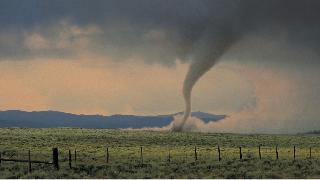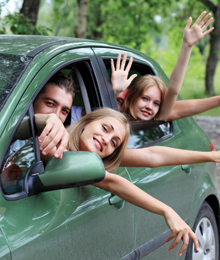
by Flagship Staff | May 22, 2017 | Blog
The electrical load on a household has significantly increased in the last 50 years. Today most people have at least one computer, several televisions, gaming systems, cell phones … all requiring electricity. According to the US Census Bureau, more than half the homes in the US were constructed before 1970, before many of these modern conveniences were invented. Amy Justman, personal lines senior underwriter, will explain if your house is at risk.
Before 1970, 60amp two-wire service was common. Today, minimums start at 100amp, three-wire service. Depending on the size of the home and its electrical load, 150 or 200amps may be required. Therefore, unless a home’s electrical system has been upgraded, it’s outdated and at risk of being overburdened.
Additionally, there are two brands of circuit breaker panels manufactured between 1950 and 1990 that have serious design flaws and put older homes with these panels at even more risk. They are Zinsco and Federal Pacific Electric (FPE) panels along with Stab-Loc circuit breakers. Now obsolete, millions of homes still have these panels today. While they may work fine for years, one overcurrent or short circuit and they can overheat and start a fire.
Experts report that both FPE and Zinsco breaker panels have major faults that could pose a real danger for fire, electrical shock, and injury:
1.They don’t meet today’s updated safety codes.
2.They have significant design flaws.
3.They may have manufacturing defects.
Inside Federal Pacific panels, there are several potential problems with the breakers: overcrowding, loose connections, they can easily split, and they may still be active when in the off or down position.
In addition to these concerns, the found that, when using UL 289 test conditions, the materials used to construct the breakers may be weak. As a result, the breakers may not trip and the panel could catch fire.
Each year, an estimated 2,800 fires directly result from Federal Pacific panel breaker malfunction. Federal Pacific Electric has been out of business for many years, but the danger and damage caused by their negligence continues.
Problems with certain Zinsco panels may not be easily visible; however, electricians often find that breakers cannot be removed from the bus bar because they melted together. In that condition, a breaker would be unable to trip, allowing an unsafe amount of electricity into the home. This could lead to a potential fire.
A second known failure is when the breakers blow out the side, causing an electrical arc explosion.
And a third problem is that even if they appear to be shut off, they can still be conducting electricity which puts you at risk for electrical shock! Only licensed electricians should inspect and remove these breakers. It’s recommended the entire electrical panel be replaced, not just the damaged circuit breakers.
The circuit breaker panel is one of a home’s most important mechanical systems. If you have one of these panels or you have less than 100 amp electrical service, please contact a licensed electrician for an inspection. The cost of maintaining the electrical system is well worth the investment to keep your home, and more importantly your family, safe.
Do you have any tips or information you’d like to share? I’d love to hear them; please share them in the box below.
Source
http://www.ismypanelsafe.com/index.aspx

by Flagship Staff | May 15, 2017 | Blog
With nicer weather on the way, we’ll start seeing a flurry of activity in our neighborhoods. Neighbors will begin walking/running, grilling out, and starting yard cleanup to deal with what Mother Nature left behind.
Neighborhood kids will begin knocking on your door to see if your kids can play. Scooters, bikes, and trampolines will be back in use.
With this flurry of activity, it’s important to make sure your property is safe for your children and their friends. All too often we hear news reports about children being injured or killed while playing outside.
Here are some safety tips that can keep your children, their friends, and your neighborhood safe.
Overhead garage door
Every day we drive in and out of the garage. With the simple push of a button, we can open and close our overhead garage door without much effort.
Have you ever taken the time to make sure your garage door is operating safely? Today, overhead garage doors have photo eyes (safety sensors) that are mounted approximately six inches off the floor. If an object blocks the view of the photo eyes, the door shouldn’t close.
Bumping into the sensors with your lawnmower or bicycle, however, can knock these sensors out of alignment and result in them not operating correctly. Check out three quick safety tips from LiftMaster to make sure your garage door safety features are working properly.
Garage utility/service door
Depending on weather patterns and the direction your garage faces, wind can whip through your garage aggressively. If you leave your service door open, it’s important to make sure the wind can’t slam it shut. When my brother was a young boy, he almost lost a finger because the wind caught the door. Consider installing a doorstop on your service door. This way, you can go in and out when working on yard projects and your kids will remain safe.
Backing out of the driveway
So often we hear tragic stories about people backing out of their driveways and injuring or killing a small child. If you have small children, or they live in your neighborhood, be extra cautious.
If you can avoid backing out of your driveway whenever possible, that’s the safest route. If not, walk around your car and look for children playing in your driveway or riding up and down the sidewalk on their bicycles. If the area looks clear, slowly back out and listen. I recommend keeping the radio off. Laughing or screaming children can be a sign they’re entering your area. Continuously turn your head and look in the mirrors. If you have a back-up camera, don’t rely on this 100% of the time. They do have some limitations.
Uneven concrete
Winter weather can be brutal on sidewalks, driveways, and roadways, causing significant cracking and shifting of concrete. If you notice large cracks or uneven concrete on your property, consider having it repaired right away. This can help avoid trip and falls which could lead to significant injuries.
Cabinets
If your garage cabinet is like mine, you probably store chemicals and yard tools that can be dangerous to small children. Here are a couple of recommendations to keep them safe.
1. Buy a cabinet that locks.
2. Don’t store your kid’s toys on lower shelves. Buy/use a different cabinet for their toys.
3. Store dangerous chemicals or sharp pruning tools on high shelves out of the reach of children.
4. Talk to your children about safety and explain to them why they need to stay away from the cabinet.
Do you have any tips or information you’d like to share? I’d love to hear them; please share them in the box below.

by Flagship Staff | May 8, 2017 | Blog
Mother Nature has been a bit slow in turning up the heat this spring; however, when she does, you’ll probably start thinking about yard work and outdoor projects you want to accomplish this year.
If you have a large project on your list, it may be time to call in a landscape professional. Here are some things to keep in mind when looking for the right landscape contractor for your job.
1. Set a budget. It’s wise to estimate project costs ahead of time. Your concept may not be in accord with your pocket book. By setting a budget, you’ll be able to find the appropriate landscaper for the job. Since every landscaper prefers a certain job, it doesn’t pay to call a landscaper who’s interested in $25,000 jobs if yours is only $5,000.
2. Make sure the landscaper is properly insured. It’s important to make sure the landscape professional can provide proof of workers’ compensation and liability insurance. Workers’ compensation insurance provides protection in case a worker is injured while doing a job on your property. Liability insurance protects your property. Never assume the landscape contractor has insurance. That assumption could cost you money in damages.
3. Ask for references. While you can do a lot of research on the internet, good old-fashioned references may be the safer way to go. Just because someone has a nice website page and photos, doesn’t mean they’re qualified to do the work. Affordable stock photos can be purchased by anyone.
4. Get it in writing. Having a written contract in place can put your mind at ease. Written contracts can identify:
–Start and completion dates
–Scope of the work to be completed
–Pricing
–Payment schedule
–Contact information
5. Check with the Better Business Bureau. Researching a contractor on the BBB’s website can be very helpful. The BBB Business Review provides:
–Contact information
–Description of the company
–Complaints
–Customer reviews
–BBB rating
–Number of years in business
–The type of work they do
–The management team
6. Go with your gut. As with anything in life, there are times when you get a feeling that something isn’t right. If you experience that when meeting with a landscape contractor, don’t ignore it. Remember, it’s your home and your money. You want to enjoy your project when it’s completed not look at it with regret.

by Flagship Staff | May 1, 2017 | Blog
While the greatest number of tornadoes occurs in April, May, and June, tornadoes can occur at any time of the year, day or night. Fortunately everybody has the chance to survive a tornado. The keys to survival are preparedness and action. If you and your family are prepared ahead of time, you’ll be able to take the necessary action steps to survive a tornado and its aftermath. Here are some tips and resources to help prepare you and your family for a tornado and keep you all safe.
While we rely heavily on technology and weather alerts today, there are some signs that Mother Nature provides before a tornado. They are:
1. Green sky/clouds;
2. Hail;
3. Flying debris;
4. Low-lying cloud with a rotation;
5. Stillness and quiet; and
6. The sound of a freight train coming toward your neighborhood.
Tornado safety tips before the storm
1. Be prepared – Tornadoes can strike at any time, 365 days a year, with or without warning. Make sure your family knows your plan of action if a tornado warning is issued for your community. Some things to consider include discussing the best place to take shelter in your home, the difference between watches and warnings, the county you reside in, steps you will take during and after the storm, and creating a safety kit.
2. Practice, practice, practice – Being prepared for a tornado is just the first step in keeping your family safe. If you don’t practice the steps you put in place, panic and injury could occur.
Throughout the year, we have several practice drills at West Bend. We practice for fires, severe weather, and other life-threatening events. Our event disaster team does a good job of changing up the situation to make us think about what we’re doing. Take the opportunity to practice with your family. If you know your child’s school is conducting a tornado drill, take the opportunity that same day to practice at home. Also, ask your family questions about your plan and different aspects of a tornado, such as the signs of severe weather and where to take shelter.
3. Protect important information – Consider storing important information in your safe, storm shelter, safety deposit box at your local bank, or electronically. Important information could include your insurance policy, loan/mortgage papers, medical information (i.e., allergies, regular medications, or a brief medical history), important telephone numbers, a personal home inventory, birth certificates, and social security cards.
Tornado safety tips during the storm
1. If your home has a basement, seek shelter there immediately. If there’s a sturdy object in your basement, like a workbench or pool table, crawl under it to protect yourself from falling objects. If your basement has windows like mine, consider a place away from the windows. The safest spot in my basement is in the closet under the stairs.
2. If your home doesn’t have a basement, seek shelter immediately in an interior room like a closet or bathroom.
3. If you live in a mobile home or are camping in a camper, consider finding a designated safety shelter.
4. If you’re driving, seek shelter immediately or drive away from the tornado at a right 90-degree angle because tornadoes usually travel from west to east. Also, parking under an overpass will not protect you from a tornado. We’ve all seen pictures and TV footage where vehicles, including semi-trucks, are thrown around like toys. Find a ditch, culvert, or other low-lying area and cover your head. Be cautious of water flow if lying in a ditch or culvert.
5. If you’re watching your children performing at a concert in a school auditorium or watching them participate in their favorite sport in a school gym, be aware of your surroundings and identify a safe area where you could seek shelter.
6. If you live in a dormitory or apartment building, find safety at the lowest place you have access and the most interior part of the building. Use stairwells to get there and, like fires, avoid using the elevator.
Tornado safety tips after the storm
1. If you’re away from your home at the time of the tornado, try to return safely. Listen to news reports to see if you can get up-to-date information about your neighborhood. Watch for fallen debris and power lines, and heed the advice of local authorities.
2. If your home has been damaged, consider turning off your main utilities, including your natural gas, electricity, and water main. If you smell natural gas, do not enter your home and call 911.
3. Only consume food or water that was not damaged by the storm.
4. If your home has minimal water damage, consider cleaning the area with bleach. Make sure you wear rubber boats, gloves, and eye protection. The area should be properly ventilated so open windows and use fans.
5. If you lost power, protect yourself from carbon monoxide poisoning by using generators, grills, and other fuel-burning devices in a well-ventilated area.
6. If your home was not damaged, contact your friends, family, and neighbors to make sure they’re safe. Ask them if they need a safe place to stay.
7. If possible, review your insurance policy and follow the necessary steps to contact them and file a claim.

by Flagship Staff | Apr 24, 2017 | Blog
Summer is officially here! Unfortunately, for teen drivers, this is the deadliest time of year.
More teens are now on the road going to their summer jobs, visiting friends, and travelling to summer attractions. This means more cars driven by inexperienced drivers.
Here are a few reasons why summer is more dangerous for teen drivers:
1.Inexperience. Instead of going back and forth to school, teen drivers are spending more time cruising around. Unfortunately, their lack of experience makes them unable to recognize hazardous situations and underestimate dangerous situations.
2.Increased road congestion. Road congestion increases significantly this time of year. Orange construction barrels litter our roadways. In addition, families are making their annual vacation treks. This extra congestion can lead to erratic driving, road rage, and sudden stops.
3.Distracted driving. Obviously, texting and driving is dangerous. So is loud music and conversations with friends.
4.More likely to engage in risky behaviors. Driving with a car full of friends not only causes drivers to become more easily distracted, they may also feel pressured to participate in risky behaviors.
5.More time is spent driving at night. According to the National Safety Council, vehicle death rates at night are three times higher than during the day. Later curfews make for more cruising time on potentially unfamiliar roads. Adding darkness to the mix could cause them to underestimate a curve or run a stop sign. In addition, darting animals could cause them to swerve out of control. Lastly, they could be sharing the road with drunk drivers or drivers falling asleep at the wheel.
Tips for keeping your teen driver safe:
1.Seatbelts save lives. I’m amazed at the number of fatal accidents in the last few months in which occupants weren’t wearing seatbelts. Wearing a seatbelt is a basic concept. According to the CDC, people who wear seatbelts cut their chances of being seriously injured or killed in a crash in half. Every time I hear about an accident in which a fatality occurred because of an ejection, I tell my kids about it and explain how important a seatbelt is.
2.Talk to them about warning lights. Again, as cars become smarter, more systems are being monitored. Go through your owner’s manual and explain to your child what each warning light means. Pay particular attention to tire pressure. Underinflated tires are more dangerous than overinflated.
3.Educate your kids on different driving conditions. Did you know you shouldn’t use cruise control in the rain? Do you know what to do if your vehicle hydroplanes? If you don’t know the answers to these questions, how can you expect your kids to know? Cruise control shouldn’t be used in rainy conditions because it could cause your car’s tires to lose contact with the pavement.
4.Make sure headlights work properly. Headlights should be properly adjusted for nighttime driving. In addition, the headlight lenses should be clear of debris. If your lens covers are cloudy and it’s difficult for light to pass through, clean them or order new ones.
5.Make sure your teen’s car has good tires. Tires are the most important part of your car. We rely on four tires with a contact patch the size of our hands to keep us travelling down the road safely. So keeping your tires in good shape is important!
6.Limit the number of friends in the car.
7.Establish open communication. If your teen is going to a party that may involve underage drinking, have an honest conversation and share your expectations. While you don’t want to condone underage drinking, you shouldn’t pretend it doesn’t exist. Let them know it’s okay to call you for a ride home. Mixing alcohol and driving can be a deadly combination, especially with inexperienced drivers.
8.Don’t let your teens drive if they’re not in good physical or mental condition. If your teen works a late shift and is too tired to drive, make alternative plans. If your teen is upset over a break up or a fight with a friend, consider doing the driving.
9.Drive the speed limit. Encourage your teen drivers to drive the speed limit. While speeding could get them to their destinations a few minutes faster, is it really worth the increased risk and the potential speeding ticket? Probably not. How many times has a car passed you and a few minutes later you see it just in front of you at an exit ramp or stop light?
Do you have any tips or information on tires you’d like to share? I’d love to hear them; please share them in the box below.
Source
http://www.autotrader.com/car-news/5-safe-summer-driving-tips-for-your-teen-170002
http://www.dmv.org/how-to-guides/night.php





